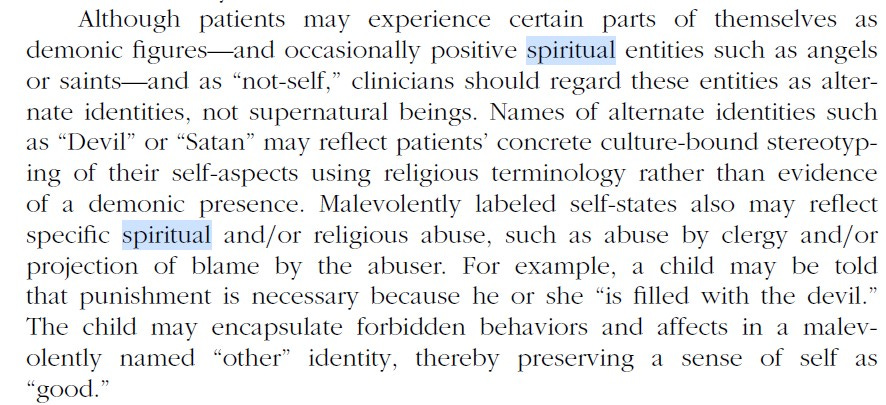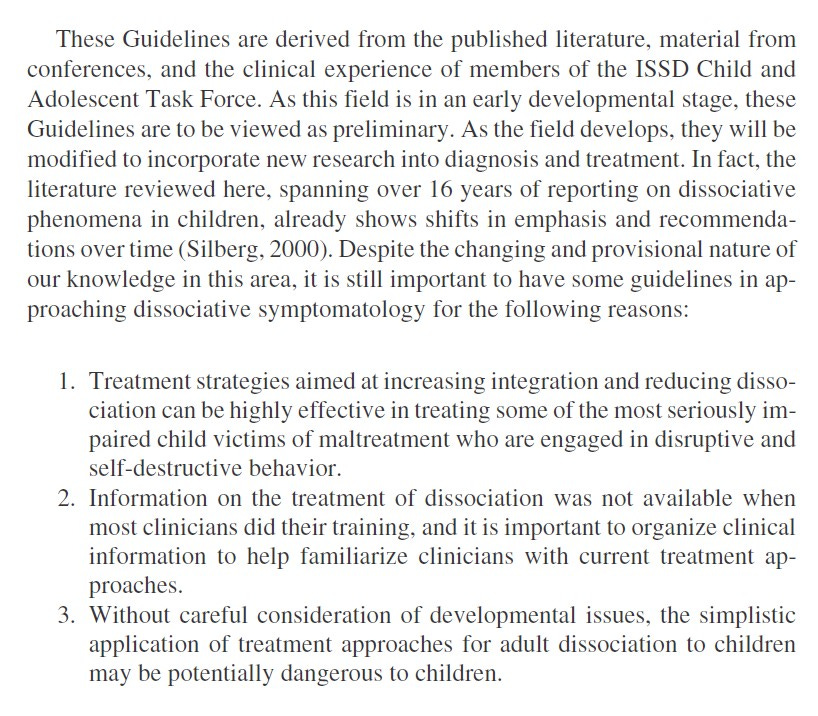The ISSTD issue guidelines for the treatment of DID. They have a set of child guidelines from 2003 and a set of adult guidelines which were updated in 2011. In this article there are links to the guidelines for information and to increase scrutiny of the ISSTD Guidelines.
There are a few screenshots and text but limited so as to not make the article too long. Names are mentioned in this post so that they are widely searchable. I recommended to read or search the guidelines. [Control and f searches documents] Possible search terms psycho, pharma, restraint, electro, spiritual, EMDR.
I just pick out some of the sections, perhaps controversial.
Adult Guidelines Revised 2011
“It is intended as a practical guide to the management of adult patients and represents a synthesis of current scientific knowledge and informed clinical practice.”
International Society for the Study of Trauma and Dissociation. (2011). [Chu, J. A., Dell, P. F., Van der Hart, O.,Cardeña, E., Barach, P. M., Somer, E., Loewenstein, R. J., Brand, B., Golston, J. C., Courtois,C. A., Bowman, E. S., Classen, C., Dorahy, M., ¸Sar, V., Gelinas, D. J., Fine, C. G., Paulsen,S., Kluft, R. P., Dalenberg, C. J., Jacobson-Levy, M., Nijenhuis, E. R. S., Boon, S., Chefetz, R.A., Middleton, W., Ross, C. A., Howell, E., Goodwin, G., Coons, P. M., Frankel, A. S., Steele, K., Gold, S. N., Gast, U., Young, L. M., & Twombly, J.]. Guidelines for treating dissociative identity disorder in adults, third revision. Journal of Trauma & Dissociation, 12, 115–187.
Development of DID
There are a couple of pages about the theories on the development of alters in DID but it is outside the scope of the guidelines. “It is outside the scope of these Guidelines to provide a comprehensive discussion of current theories concerning the development of alternate identities in DID.”
Later in the series, there will be some discussion of this.
Aims of Treatment
ISSTD treatment “should move the patient toward better integrated functioning whenever possible.”
R. P. Kluft (1993a) has argued that the most stable treatment outcome is final fusion—complete integration, merger, and loss of separateness—of all identity states. However, even after undergoing considerable treatment, a considerable number of DID patients will not be able to achieve final fusion and/or will not see fusion as desirable… …Accordingly, a more realistic long-term outcome for some patients may be a cooperative arrangement sometimes called a “resolution”—that is, sufficiently integrated and coordinated functioning among alternate identities to promote optimal functioning.
Pharmacological Guidelines
The guidelines place ISSTD firmly in the camp of pharmacological, psychopharmacological, allopathic, Big Pharma, Rockefeller medical system with their treatments and medications.
“It should be understood that information in the Guidelines supplements, but does not replace, generally accepted principles of psychotherapy and psychopharmacology. Treatment for DID should adhere to the basic principles of psychotherapy and psychiatric medical management, and therapists should use specialized techniques only as needed to address specific dissociative symptomatology.”
This even includes “pharmacologically facilitated interviews” which are allowed in hospital settings, although it says these are rare.
Restraints
Restraints are also still allowed for inpatients, though perhaps less used than previously.
During inpatient treatment, seclusion and physical or chemical restraints may be required for the DID patient who is behaving violently toward himself or herself or others and who has not responded to verbal, behavioral, or pharmacological interventions.
The very conditions - drugs and restraints that were sometimes used for people’s mind control and for causing their DID are allowed in ISSTD “treatment”.
ECT
Electro Convulsive Therapy is not recommended for DID but a DID patient may still undergo ECT if there is comorbid refractory depression.
ECT has not been shown to be an effective or appropriate treatment for dissociative disorders, but it may be useful in relieving a comorbid refractory depression superimposed on DID.
EMDR
There are separate guidelines for use of EMDR…
Recommended Guidelines: A General Guide to EMDR’s Use in the Dissociative Disorders (authored by the EMDR Dissociative Disorders Task Force and published in Shapiro, 1995, 2001) contains a number of recommendations. The Guide recommends that EMDR be used within an overall treatment approach rather than as a standalone treatment. If a dissociative disorder is present, only clinicians knowledgeable in the treatment of dissociative disorders should use EMDR procedures, and they should do so only after patient readiness for EMDR processing of traumatic material has been assessed. EMDR processing is recommended only when the patient is generally stable and has adequate coping skills, enough internal cooperation among alternate identities, and the ability to maintain the dual focus of awareness that is necessary in EMDR procedures.
Spiritual Aspects
ISSTD as an organisation do not seem to recognise ritual abuse as satanic, saying that some clinicians believe these experiences are misremembered.
There is a divergence of opinion in the field concerning the origins of patients’ reports of seemingly bizarre abuse experiences such as involvement in occultist or satanic “ritual” abuse and covert government sponsored mind control experiments. There are clinicians who believe that some patients’ reports of such occurrences may be rooted in actual sadistic events of organized abuse experienced by these patients in childhood, whereas other clinicians believe that patients’ actual experiences of extremely sadistic events in childhood may be misremembered.
Spiritual Healing
The approach of the ISSTD to spiritual treatment appears underwhelming. Whilst the guidelines say that “Ignoring the religious and spiritual concerns of DID patients is not recommended”, they suggest palming off the patient onto the clergy if the therapist is unable to adequately address these matters.
The ISSTD recommend that clinicians should regard parts who present as spiritual entities as alters not supernatural beings.
Reports from ex cult programmers suggest that DID can be an intentional result of widespread cult mind control techniques and programmes such as Monarch Mind Control, Mk Ultra and Carousel. Some say each alter is sealed in by a demon. Despite this ISSTD do not seem to consider this, or any anti- demonic treatment.
They say that therapists should approach exorcism with extreme caution, as two samples have found some deleterious effects. This appears vague and it would seem as if this area is ripe for research but strangely ISSTD does not seem to.
People with DID from satanic ritual abuse are often looking for a spiritual element to their healing. They want demons to be banished and many in Christian manner. The ISSTD does not appear to cater for a Christian who wants demons banished. Furthermore there appears to be no spiritual element to their recommended treatments.
Of course it is true that many churches have been compromised by satanic forces and it is as much of a nightmare for a survivor to find a trustworthy clergy as it is to find a trustworthy therapist with correct experience in ritual abuse and spiritual aspects.
DID Patients as Parents
ISSTD say DID patients have been shown to have a wide range of competence as parents—from exemplary to abusive (R. P. Kluft, 1987b). Clinicians should be aware of the potential for a DID parent to be neglectful or abusive when in particular dissociative states or because of life problems associated with this disorder.
Comments like the above are used by social services / child protective services to often unjustly take children away from perfectly good or adequate parents on the “potential risk of future harm” who are then are put into the authorities care. No risk assessments are ever taken of the chances of child trafficking or harm via the child care system. This effectively rigs the system to taking children away from parents who have been abused themselves and into a system where child abuse levels are high and many believe designed or used for child trafficking and abuse.
Therapy
To find a therapist with the correct experience is often difficult or impossible for survivors. This is more pronounced in the government aided sector but also significant in the private sector where there is the issue of excessive costs for a survivor, with therapy often needed for years.
There are significant issues of trust with survivors who have been betrayed often, and many organisations are seen as having been compromised by the cabal. Organisations have therapists, maybe even under mind control themselves, to collect information to report back and to reprogramme individuals who are showing signs of leaving the system. I am sure there is research being done by the system, as to how much they can allow front alters to leave the system yet still retain control by backdoors or deeper programming and triggers.
Due to these trust issues, cost issues, not wanting to be compromised / reprogrammed and often not wanting to go through pharmacological or “modern medicine” treatment, health systems are often seen as a can of worms by survivors.
Understandably many survivors try to heal outside the governmental / normal health system by alternative therapies or by themselves. Tapping and EMDR appear to be popular and effective. I tried to put some healing and therapy information together for survivors. Healing and Therapy Information for Mind Controlled Survivors [3], but they are just suggestions.
Children’s Guidelines
The preamble to the Children’s Guidelines, makes clear that the field
is in an early developmental stage and that they are preliminary guidelines
as the field develops they will be modified
It is 21 years later and they have not even been modified once. Why not?
“The field is in an early developmental stage, these guidelines are preliminary. As the field develops they will be modified to incorporate new research into diagnosis and treatment.”
“It is our hope that research will continue to amend and refine these Guidelines”
Has the research not been done? The field was at an early developmental stage 21 years ago, there has been a tremendous growth in knowledge about dissociation and ritual abuse and the numbers involved, why is this not reflected in the guidelines?
Guidelines developed by Joyanna Silbert, Frances Waters, Elaine Nemzer, Jeanie McIntee, Sandra Wieland, Els Grimminck, Linda Nordquist, Elizabeth Emsond, (Help from Peter Barach, James Chu, John Curtis, Beverly James, John O’Neil, Gary Peterson, Margo Rivera)
2
ISSTD Child Guidelines 2003
Conclusions
This was a brief look at some aspects of the ISSTD guidelines. I am trying to raise some questions that do not seem to be talked about elsewhere. Please feel free to comment or put links to other places where discussions of these type of authorities are taking place.
This is an interpretation of the Adult treatment guidelines by Itterman…
Previous Posts on ISSTD
ISSTD 1 - Introduction to ISSTD [fb3IS1]
ISSTD 2 - The Search for Satan (1995) [fb3IS2]
ISSTD 3 - Fiona Barnett on ISSTD's Michael Salter [fb3IS3]
Links
[1] ISSTD Adult Treatment Guidelines https://www.isst-d.org/resources/adult-treatment-guidelines/
[1a] 2011 Revised ISSTD Adult Treatment Guidelines https://web.archive.org/web/20240219012211/https://www.isst-d.org/wp-content/uploads/2019/02/GUIDELINES_REVISED2011.pdf
[2] 2003 Child Treatment Guidelines https://www.isst-d.org/resources/child-adolescent-treatment-guidelines/
[2a] 2003 Child Treatment Guidelines pdf archive https://web.archive.org/web/20240118014558/https://www.isst-d.org/wp-content/uploads/2019/02/childguidelines-ISSTD-2003.pdf
[3] 2023 Nov 18 substack foxyfox Healing and Therapy Information for Mind Controlled Survivors https://foxyfox.substack.com/p/healing-and-therapy-information-for #mkultra #mindcontrol #healing #therapy #links
[fb3IS3] 2021 Feb 18 foxblog3 ISSTD 3 - Fiona Barnett on ISSTD's Michael Salter https://foxyfox.substack.com/p/isstd-3-fiona-barnett-on-isstds-michael #fionabarnett #michaelsalter #mkultra #ritualabuse #ISSTD
Foxblog Social Media
foxblog3 Substack Blog 2021- present Foxblog3 Substack Blog and Newsletter
foxblog2 current wordpress blog https://cathyfoxblog2.wordpress.com/
foxblog1 old wordpress blog 2012-2022 https://cathyfox.wordpress.com/
CathyFoxSubstack (archive of cathyfoxblog1) Cathy Fox Blog WordPress Archive on Substack
Telegram FoxyFoxyWolf Channel https://t.me/wolfchannel2
Telegram Foxy Wolf Chat Group https://t.me/foxywolfchannelgroup
Bastyon https://bastyon.com/foxyfoxy
RSS Feeds










